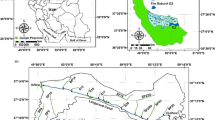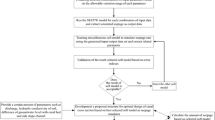Abstract
Two-third of cultivated land in India is monsoon dependent, due to global warming and the El Niño and La Niña phenomenon, an uncertainty loom occurs around monsoon which necessitates more irrigation periods. The conventional method for conveying irrigation water from the source to field is through open canals in the country causing huge losses in percolation and evaporation. Thus, modern system of irrigation such as Pipe Distribution Network (PDN) is desired. An application of PDN on the Left Bank Canal (LBC) of the Pench Irrigation project at distributary/tertiary level, India is proposed in the present study with the aim to design the least cost irrigation network of optimum pipe diameters thereby reducing the losses caused by canal for effective utilization of available water. EPANET 2.0 is used as the design tool with pressure and velocity as constraints. The design is also carried out using Critical Path Method (CPM) and optimized using Linear Programming (LP). Network costs are compared for both the approaches. Sensitivity analysis is also carried out for checking pressure variations for different materials by Hazen Williams (HW) and Darcy Weisbach (DW) major friction head loss formulas with variation in Loss Coefficients (LC). Proposed designed pipe irrigation system indicates significant reduction in losses compared to traditional conveyance system and thus will be beneficial if adopted in practice to the Indian fields which will significantly contribute to efficient management of available water.
Similar content being viewed by others
Abbreviations
- CHW :
-
Hazen Williams pipe coefficient
- CPM:
-
Critical Path Method
- CWC:
-
Central Water Commission
- C xy :
-
Unit Cost of pipe size y in link x
- DW:
-
Darcy Weisbach
- D x :
-
Diameter of pipe in mm
- FSD:
-
Full Supply Depth
- GI:
-
Galvanized Iron
- H jmin :
-
Minimum head at node j
- H o :
-
Head available at source node O
- HW:
-
Hazen Williams
- KBC:
-
Kanhan Branch Canal
- k, m :
-
Cost constant
- LBC:
-
Left Bank Canal
- LC:
-
Loss Coefficient
- LP:
-
Linear Programming
- L x :
-
Length of the pipe in meter
- L xy :
-
Length of pipe size y in link x
- PDN:
-
Pipe Distribution Network
- PSC:
-
Prestressed Concrete
- Q x :
-
flow through link x in m3/min
- S xy :
-
Friction slope for the pipe size y in link x
- T.C :
-
Total cost
- X :
-
No. of links
- Y :
-
No. of commercial pipes
References
Afshar MH, Marino MA (2007) A parameter-free self-adapting boundary genetic search for pipe network optimization. Computer Optimization Applications 37:83–102, DOI: https://doi.org/10.1007/s10589-007-9016-1
Alperovits E, Shamir U (1977) Design of optimal water distribution system. Water Resources Research 13(6):885–900, DOI: https://doi.org/10.1029/WR013i006p00885
Arora S, Jaiswal AK (2013) Optimal cost of irrigation network design using EPANET. International Journal of Computer Applications 68(21):41–44
Bentum RV, Smout IK, Ci XZ (1995) Use of pipelines to improve surface irrigation in Hebei Province, China. Journal of Irrigation and Drainage Engineering 121(6):405–410, DOI: https://doi.org/10.1061/(ASCE)0733-9437(1995)121:6(405)
Bhave PR (1978) Non-computer optimization of single source networks. Journal of Environmental Engineering 104(4):799–814
Bhave PR (1983) Optimization of gravity-fed water distribution systems: Application. Journal of Environmental Engineering 109(2): 383–395, DOI: https://doi.org/10.1061/(ASCE)0733-9372(1983)109:2(383)
Bhave PR, Gupta R (2004) Optimal design of water distribution networks for fuzzy demands. Civil Engineering and Environmental Systems 21(4):229–245, DOI: https://doi.org/10.1080/10286600412331314564
Bhave P, Gupta R (2006) Analysis of water distribution network. Narosa Publication House, New Delhi, India
Census of India (2011) Chapter 3, Retrieved November 15, 2019, http://censusindia.gov.in
Chief Engineer (2012) Schedule of rates. Thane’s Letter No. C.E. (W. M.), Report Water Management, Government of India, Maharashtra, India.
Chiplunkar AV, Khanna P (1983) Optimal design of branched water supply systems. Journal of Environmental Engineering 109(3):604–618, DOI: https://doi.org/10.1061/(ASCE)0733-9372(1983)109:3(604)
Cunha MC, Sousa J (1999) Water distribution network design optimization: Simulated annealing approach. Journal of Water Resources Planning and Management 125(4):215–221, DOI: https://doi.org/10.1061/(ASCE)0733-9496(1999)125:4(215)
CWC Guidelines (2017) Guidelines for planning and design of piped irrigation network. Central Water Commission, Government of India, New Delhi, India
Djebedjian B, Yaseen A, Rayan M (2006) Optimization of large water distribution network design using Genetic Algorithm. Proceedings of 10th international water technology conference, March 23–25, Alexandria, Egypt, 447–477
Ensuff MM, Lansey KE (2003) Optimization of water distribution network design using the shuffled frog leaping algorithm. Journal of Water Resources Planning and Management 129(3):210–225, DOI: https://doi.org/10.1061/(ASCE)0733-9496(2003)129:3(210)
Farmani R, Abadia R, Savic D (2007) Optimum design and management of pressurized branched irrigation networks. Journal of Irrigation and Drainage Engineering 133(6):528–537, DOI: https://doi.org/10.1061/(ASCE)0733-9437(2007)133:6(528)
Farmani R, Wright AJ, Savic AD, Walters AG (2005) Self-adaptive fitness formulation for evolutionary constrained optimization of water systems. Journal of Computing in Civil Engineering 19(2): 212–216, DOI: https://doi.org/10.1061/(ASCE)0887-3801(2005)19:2(212)
Fujiwara O, Dey D (1988) Method of optimal design of branched network on flat terrain. Journal of Environmental Engineering 114(6):1464–1475, DOI: https://doi.org/10.1061/(ASCE)0733-9372(1988)114:6(1464)
Halagalimath S, Vijaykumar H, Patil SN (2016) Hydraulic modeling of water supply network using EPANET. International Research Journal of Engineering and Technology 3(3):1022–1027
Hansen CT, Madsen K, Nielsen HB (1991) Optimization of pipe networks. Mathematical Programming 52(1–3):45–58, DOI: https://doi.org/10.1007/BF01582879
Huddleston DH, Alarcon VJ, Chen W (2004) Water distribution network analysis using Excel. Journal of Hydraulic Engineering 130(10): 1033–1035, DOI: https://doi.org/10.1061/(ASCE)0733-9429(2004)130:10(1033)
IPCC (2013) Climate change 2013: The physical science basis. Working Group I to the 5th Assessment Report of the Intergovernmental Panel on Climate Change, Cambridge University Press, Cambridge, UK, 1535
IPCC (2018) Global warming of 1.5°C. World Meteorological Organization, Geneva, Switzerland.
Kadu MS, Gupta R, Bhave PR (2008) Optimal design of water networks using a modified genetic algorithm with reduction in search space. Journal of Water Resources Planning and Management 134(2):147–160, DOI: https://doi.org/10.1061/(ASCE)0733-9496(2008)134:2(147)
Kanakis PC, Papamichail DM, Georgiou PE (2014) Performance analysis of on-demand pressurized irrigation network designed with linear and fuzzy linear programming. Irrigation and Drainage 63:451–462, DOI: https://doi.org/10.1002/ird.1853
Kumar A, Kumar K, Bharanidharan B, Matial N, Dey E, Singh M, Thakur V, Sharma S, Malhotra N (2015) Design of water distribution system using epanet. International Journal of Advanced Research 3(9):789–812
Liu H, Yaun Y, Zhao M, Fang H, Zhao H (2010) Hybrid multi-objective genetic algorithm for optimal design of water supply network. Proceedings of 12th annual conference on water distribution system analysis, September 12–15, ASCE, Tucson, AZ, USA, 899–908
Maier HR, Simpson AR, Zecchin AC, Foong WK, Phang KY, Seah HY, Tan CL (2003) Ant colony optimization for design of water distribution systems. Journal of Water Resources Planning and Management 129(3):200–209, DOI: https://doi.org/10.1061/(ASCE)0733-9496(2003)129:3(200)
Mansouri R, Torabi H, Hoseini M, Morshedzadeh H (2015) Optimization of the water distribution networks with differential evolution (DE) and mixed integer linear programming (MILP). Journal of Water Resource and Protection 7:715–729, DOI: https://doi.org/10.4236/jwarp.2015.79059
Monem MJ, Namdarian R (2005) Application of simulated annealing (SA) techniques for optimal water distribution in irrigation canals. Irrigation and Drainage 54:365–373, DOI: https://doi.org/10.1002/ird.199
Page PR (2015) Smart optimisation and sensitivity analysis in water distribution systems. Proceedings of smart and sustainable built environment (SASBE) conference, December 9–11, Pretoria, South Africa
Pench Irrigation Project Report (2001) Performance evaluation study of Pench irrigation project. Government of India, Maharashtra, India
Prasad TD, Hong SH, Park N (2003) Reliability based design of water distribution networks using multi-objective genetic algorithms. KSCE Journal of Civil Engineering 7(3):351–361, DOI: https://doi.org/10.1007/BF02831784
Prasad TD, Park NS (2004) Multiobjective genetic algorithms for design of water distribution networks. Journal of Water Resources Planning and Management 130(1):73–82, DOI: https://doi.org/10.1061/(ASCE)0733-9496(2004)130:1(73)
Radhakrishnan K, Sivaraman I, Jena SK, Sarkar S, Adhikari S (2017) A climate trend analysis of temperature and rainfall in India. Climate Change and Environmental Sustainability 5(2):146–153, DOI: https://doi.org/10.5958/2320-642X.2017.00014.X
Ramos H, Tamminen S, Covas D (2009) Water supply system performance for different pipe materials Part II: Sensitivity analysis to pressure variation. Water Resources Management 23:367–393, DOI: https://doi.org/10.1007/s11269-008-9279-z
Renault D (2000) Aggregated hydraulic sensitivity indicators for irrigation system behavior. Agricultural Water Management 43:151–171, DOI: https://doi.org/10.1016/S0378-3774(99)00059-1
Rossman LA (2000) EPANET 2 user’s manual. EPA/600/R-00/057, US EPA, Cincinnati, OH, USA
Samani SMV, Mottaghi A (2006) Optimization of water distribution networks using integer linear programming. Journal of Hydraulic Engineering 132(5):501–509, DOI: https://doi.org/10.1061/(ASCE)0733-9429(2006)132:5(501)
Sarbu I (2010) Optimization of water distribution networks. Proceedings of the Romanian Academy, Series A 11(4):330–339
Satpute MM, Khandve PV, Gulhane ML (2012) Pipe distribution network for irrigation-an alternative to flow irrigation. Proceedings of 99th indian science congress, January 3–7, Bhubaneshwar, India, 106–114
Smout IK (1999) Use of low-pressure pipe systems for greater efficiency. Agricultural Water Management 40:107–110, DOI: https://doi.org/10.1016/S0378-3774(98)00089-4
Srivastava RC, Mohanty S, Singandhupe RB, Biswal AK, Ray LIP, Sahoo D (2006) Studies on canal water based pressurized irrigation system in a minor irrigation command. Journal of Agricultural Engineering 43(4):28–35
Srivastava RC, Mohanty S, Singandhuppe RB, Mohanty R, Behera MS, Ray LIP, Sahoo D (2010) Feasibility evaluation of pressurized irrigation in canal commands. Water Resources Management 24(12):3017–3032, DOI: https://doi.org/10.1007/s11269-010-9592-1
Thornton PK, Ericksen PJ, Herrero M, Challinor AJ (2014) Climate variability and vulnerability to climate change: A review. Global Change Biology 20(11):3313–3328, DOI: https://doi.org/10.1111/gcb.12581
Todini E (2008) Design, expansion, and rehabilitation of water distribution networks aimed at reducing water losses. Where are we? Proceedings of the 10th annual water distribution systems analysis conference, August 17–20, Tucson, AZ, USA, 17–20
Vairavamoorthy K, Ali M (2005) Pipe index vector: A method to improve genetic-algorithm-based pipe optimization. Journal of Hydraulic Engineering 131(12):1117–1125, DOI: https://doi.org/10.1061/(ASCE)0733-9429(2005)131:12(1117)
Young B (1994) Design of branched water supply network on uneven terrain. Journal of Environmental Engineering 120(4):974–979
Acknowledgements
The authors are thankful to the Pench Irrigation Division, Nagpur Maharashtra, India under Vidarbha Irrigation Development Corporation, for providing the necessary data to carry out the present study.
Author information
Authors and Affiliations
Corresponding author
Rights and permissions
About this article
Cite this article
Gajghate, P.W., Mirajkar, A. Irrigation Pipe Network Planning at Tertiary Level: An Indian Case Study. KSCE J Civ Eng 24, 322–335 (2020). https://doi.org/10.1007/s12205-020-0272-2
Received:
Revised:
Accepted:
Published:
Issue Date:
DOI: https://doi.org/10.1007/s12205-020-0272-2




